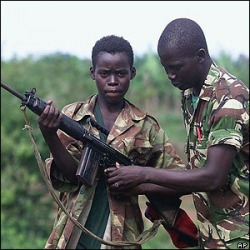Sierra Leone: War
by Jake Bobrow
Title.
Sierra Leone: War
Sierra Leone has been in a constant state of war and violence since 1991. This war has been triggered by years of colonial struggle and corrupt governments. The main cause of the current wars and violence in Sierra Leone is a Militant group called the Revolutionary United Front. This organization has been causing havoc throughout Sierra Leone by attacking villages and taking over diamond mines. The NPRC (National Provisional Ruling Council) has been trying to extinguish the RUF and have had some signs of success.
At first, the NPRC proved to be nearly ineffectual in repelling the RUF. More and more of the country fell to RUF fighters, so that by 1995 they held much of the countryside and were on the doorsteps of Freetown (the countries capital). To better the situation, the NPRC hired several hundred mercenaries from the private firm Executive Outcomes. Within a month they had driven RUF fighters back along Sierra Leone’s borders. As a result of popular demand and international pressure, the NPRC agreed to hand over power to a civilian government and presidential elections, which were held in April 1996. Ahmad Tejan Kabbah, a diplomat who had worked at the UN for more than 20 years, won the presidential election. However, on May 25, 1997 the Armed Forces Revolutionary Council (AFRC), led by Maj. Johnny Paul Koroma, overthrew President Kabbah and later invited the RUF to join the government. In March 1998 the Nigerian-led ECOMOG forces overthrew the AFRC after 10 months in office, and reinstated the democratically elected government of President Kabbah. The RUF’s renewed attempts to overthrow the government in January 1999 brought the fighting to parts of Freetown, leaving thousands dead and wounded.
President Kabbah and RUF leader Sankoh on July 7, 1999, signed the Lomé Peace Agreement, which made Sankoh Vice President and gave other RUF members positions in the government. This act called for an international peacekeeping force run initially by both ECOMOG and the United Nations. The UN Security Council established the United Nations Mission in Sierra Leone (UNAMSIL) in 1999, with a force of 6,000 ECOMOG forces departed in April 2000. Almost immediately the RUF began to violate the agreement by holding hundreds of UNAMSIL personnel hostage and capturing their weapons and ammunition. On May 8, 2000, members of the RUF shot and killed as many as 20 people demonstrating against the RUF violations outside Sankoh's house in Freetown.
As you can see the RUF is clearly responsible for the violence that has arisen in Sierra Leone. Sadly, Sierra Leone is still a land of war and conflict. But just recently the world has been more informed of the horrible events that occur there. If more people are taught about modern African history then there is a greater chance that it will become a peaceful nation. If everyone focuses on this problem great things can be accomplished. We as citizens of the Earth are obliged to help our fellow humans; this is why it is essential that we educate ourselves and others about foreign struggles. We have great power; all we need to do is use it for justice.
Title.
Paragraph.


